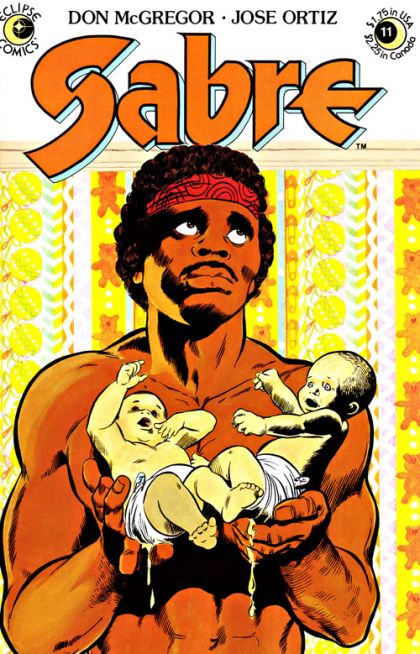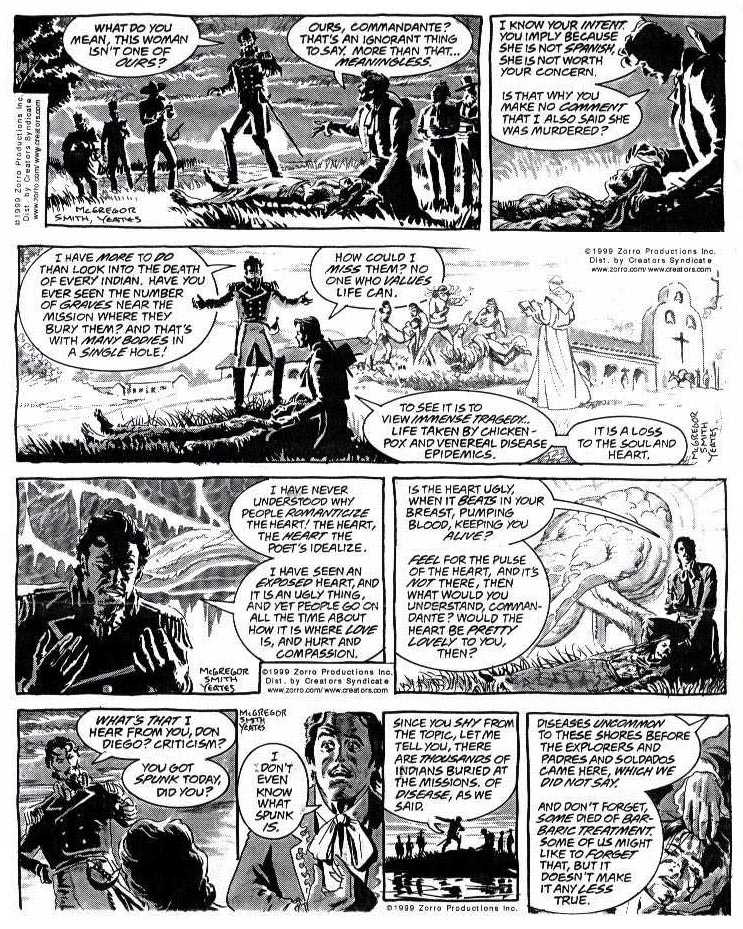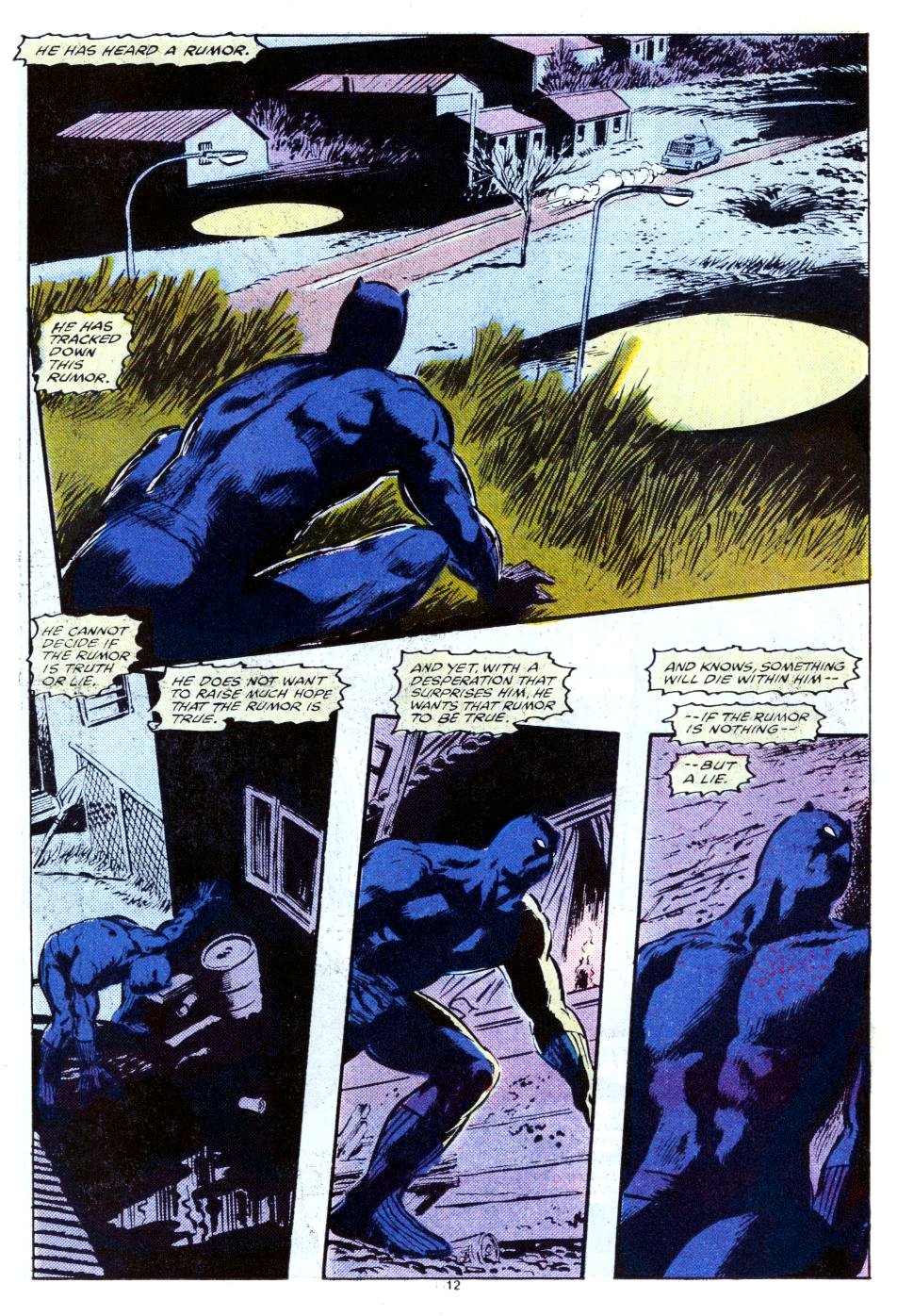Read the introduction to the Great Sabre Interview
Read Part One of the Great Sabre Interview
Read Part Two of the Great Sabre Interview
Read Part Three of the Great Sabre Interview
Read Part Four of the Great Sabre Interview
Read Part Five of the Great Sabre Interview
Read Part Six of the Great Sabre Interview
Read Part Seven of the Great Sabre Interview
Read Part One of the Great Sabre Interview
Read Part Two of the Great Sabre Interview
Read Part Three of the Great Sabre Interview
Read Part Four of the Great Sabre Interview
Read Part Five of the Great Sabre Interview
Read Part Six of the Great Sabre Interview
Read Part Seven of the Great Sabre Interview
If you enjoy reading this interview, please consider supporting the Sabre: the Early Future Years Kickstarter project.
Don McGregor: It was always a concentrated effort on the books, an intense focus and trying to really get the most out of a scene, but also, especially over the course of time, to keep the larger parameters of what the characters and book are, to not lose that larger vision. It can happen, more often when you go away from a project for awhile and then come back to it, to get your mind where it was when you were doing it, to find that voice again,
Scripting a comic book is far removed from writing a "Riding Shotgun" piece that appears on my website, donmcgregor.com and Comics Bulletin. The comics demand different kinds of writing. It's not just the tone of words the reader sees, but it's keeping the visuals in mind and the design, what the artist needs to know, in a way that's clear to him or her, what's needed and why.
Your idea, Jason, to do Sabre: The Early Future Years as a Kickstarter program set the possibility of the story reaching an audience into motion. After all these years of working on this series, from when it was first scripted, to working with different artists on it, from watching it go from active to stalled, it's difficult to keep your emotional balance, not to become too dispirited if it doesn't happen. And it can go that way. But life is going to on, and you've got to fight to find a way not to let it totally grind you to a halt.
As it goes along, the Kickstarter endeavor reveals how much needs to be done to help it succeed. It has nothing to do with the actual writing, it has to do with getting people aware that it can exist, getting it to people who might want it if they realized it was on a possible horizon.
And this is an emotional rollercoaster for me.
And if Sabre: The Early Future Years does get done, it may pave the way for the new Detectives Inc.: A Fear of Perverse Photos/A Repercussion of Violent Reprisal. This is thrilling. It really is. It's a jolting spark of life in me!
Jason Sacks for Comics Bulletin: That makes me so happy and there are going to be so many people that are so thrilled to get to see this material again, or mostly for the first time.
McGregor: I know you told me that; I hope that's true. I hope they do finally get to read and experience Sabre: The Early Future Years. I think I have said to you at least once, maybe more, that when I came back to writing the series, one of my biggest, initial fears was that I hope the fans who love Sabre, and have loved my work over the years, don't read the book and think, "Damn, Don had it 17 years ago. He should have left it the fuck alone."
I guess that's part of the fear and challenge for me when I'm creating. I can recall it going all the way back. When there was so much response to "Panther's Rage" and "Killraven", for instance, and the mail kept increasing, and the letters were so in depth and detailing what the stories meant to them, I have used this analogy before, but it's like climbing this mountainside, getting higher and higher, and there were certainly times I was daunted. Despite the nickname title of "Dauntless Don". There was so much enthusiasm - which was great, don't get me wrong - but the other side of that, each time I sat down to write, there were those moments when I thought, "This is it! This issue will come out, and I'll have gone over the edge of the cliff." Or maybe that was just a residual of the kind of vibe I got every issue from editorial.
I ended up really enjoying the back and forth, give and take, with the readers, and you can certainly see it in the Sabreseries. I had room to lengthen the letters pages in some issues, and could print longer letters and more specific responses to readers' questions, views and ideas. If you don't have that reaction, it's as if the words have gone into the ether and disappeared. And if you do go off the edge of the cliff for some people, or if you feel you failed on your own terms, you have the chance to look at it, try to figure why it didn't work, and hopefully learn from it. Let's take the risk and try it again.
Sometimes I'd think, "Why am I putting myself through all this?" But, I think you both can relate to this as fans of the medium, there are those times, as we've discussed, where the artist just sings, brings a scene to life better than you ever hoped for as you battled the fear to finish the script. And it's a joy! And for me, it's like, "Okay! I'll go through this again! To get to here! This...THIS is why I LOVE comics!"
So, earlier, when you asked me about the artists, and particularly about Billy Graham, the artists were the people I was often closest to. I loved working with Billy because there wasn't anything I couldn't do with Billy and we had such a great rapport with each other. I don't want to tell too many Billy Graham stories because when "An Exploitation of Everything Dear" gets done as a single volume, as I've been told many times over that it will happen, (but getting the obliterating coloring out of the art that comes so close to the black line that even with the computer technology it is still too difficult to achieve), I'll tell a lot of Billy Graham stories, where those times together will have a place of some sort of permanence for those who want to know my experiences with him.
And some of them are fun, interesting, and bizarre at times.
Welcome to New York City!
I never met José Ortiz. I loved his work. I don't know if he could read English or if all the scripts were translated for him, but God he followed those scripts exactingly. I mean anything, any page design I wanted, and, more importantly, he really understood the tone of individual scenes.
You can't do a sequence with Winslow Butterfingers walking around with his paint bucket robot buddy, Aloysuis, trudging in circles through-out the snow with the same intent as Sabre on a harangue about corporate and political dictates and the abuse of power, or to a sequence with the kind of sexuality we have been talking about. This expansive approach needs visual approaches that capture the tenor of that scene.
José was also good at conveying how the characters connect within a panel. I can recall one with Sabre whispering into Melissa's ear, and the expression on her face is so apt, that he understood the nuance of what I was asking for.
I thought Jose's downside was capturing the intensity and power of Sabre himself. He's the person who walks into the room, and everyone knows he is there. There's an aura of strength about him, a calm self-assurance, it's physical and spiritual. You know if all hell breaks loose, this is the guy you want to be around.
So, for Sabre, all of it really begins to come together for me with Sabre #7.
I've probably stated this earlier, but I've been incredibly fortunate over the years that a lot of people that I worked with as artists became really close friends. On many of my projects, I am with them day in and day out, as the book is being drawn, discussing it, going over panels, pages, a single scene, whatever. There is a bond that grows when you're both committed to what you are doing. As a writer, a part of the job, to me, is keeping everybody's energy up, or as much as I can, because this can get wearying when you're in the thick of it, and the end seems like it will never even come into sight—it's trying to keep alive all the reasons you are in the midst of this.
But just think of some of the names of these wonderful, talented people who I have had the chance to know and create with.
You can go from Craig Russell to Rich Buckler to Marshall Rogers to Tom Yeates. I mean, Tom Yeates and Zorro. One of the most favourite things I have ever done was the Zorro newspaper strip with Tom, from Tusk Envy, Dead Body Rising, and Easy Victim.
Tom is such a talented guy, but he's also such an incredibly nice guy, with easy charm and an artist's concerns.
There's Mike Mayhew and Dwayne Turner, who were at the beginning of their careers when I worked with them. I took a chance with Dwayne. He hadn't drawn a lot of comics, and certainly nothing resembling anything I wanted to do withPanther's Prey, but when we did that mini-series together we were on the phone every day. It all happened because I was Xeroxing something after hours at Marvel, and Chris Ivy asked me if I was going to use Dwayne, and that the Panther was his favorite character. And I thought, "I want someone who loves the Panther, and this isn't just another gig to him."
We became close friends, and I saw a lot of him and wife, Robin, before they moved out to the West Coast. But it was such a pleasurable time, working with Dwayne, both of us excited about the next page, the next challenge. I took a gamble and it couldn't have worked out better.

Craig Russell. I mean Craig was just phenomenal. He's just phenomenal. I don't know what else to say. The man has so much talent; he's so gracious and discerning. I had great times with all these people as well as working on the books with them. The things that we did together, during those time periods, that part of it, working with them, I treasure.
Ron Wagner – We did an adaptation of The Mask of Zorro movie into comics. I didn't know Ron. I worked my ass off on that book and I know we gave the people their money's worth.
Tom Palmer. I first got to see I Spy again through Tom Palmer. Tom was an incredibly nice guy and if you had to have inks on Gene Colan, that's who I went for: Tom Palmer.
I got him to come and do "Panther's Quest" and I remember Tom said to me, "I thought it was just going to be an eight page chapter." he said, "I didn't know it was going to go on for twenty five books." "Well, neither did I, Tom." I think Terry Kavanagh came to me about chapter twelve and he said, "Don, I've got to give them something." I think Tom DeFalco was all over him about this. "I've got to give him a number." And off the top of my head I said, "Twenty five."
In the middle of that, there's one chapter, I think that is ten pages. I don't know if you remember Marvel Comics Presents, they were all eight page stories and that dictated that format and I needed ten pages for one of the chapters. I knew Terry had no stories that were six pages. They were all eight. I said, "Terry, if you give me ten I'll write any character you want and write a six page story. I didn't want to do a six page story, but that was the price to get those added pages. I ended up doing a six-page Sub-Mariner story with Jim Lee. I wrote the story, and when I was finished, I decided, Nope! I'm going to do this as a silent story, and completely wrote the same story, but without any captions of dialogue.
At the end of "Panther's Quest" I didn't have enough room to do the big ending I wanted. I went to Terry Kavanagh and asked if we could do double-size chapters, since it had to end at 25. And Terry said something like, that it was fine. It made his job easier, he didn't have to scrounge around trying to dig up another team for some eight page story, and he got Don McGregor and Gene Colan and Tom Palmer for his anthology book
I know there are many others I should mention, but I'll end with Gene Colan. I still miss him dearly. To have the artist ofHopalong Cassidy through Daredevil and what Gene drew, bringing some of my stories to life, was one of those things that just brings a smile to my face. I saved Ragamuffins for years, waiting until Gene was free enough to be able to draw the scripts. Even at the end, when Gene was in the hospice, he was still so alert. I sat at his bedside, and he held my hand in those huge, strong hands of his, and we talked about life and meaning and laughed at things we had shared together.

And remember, Gene drew the cover with Sabre and the babies peeing. He caught exactly the look on Sabre's face I wanted.
Sacks: What do you hope people's reaction will be to Sabre in 2013?
McGregor: I hope they'll love it. I hope it will speak to them and mean something to them. All the things I guess I hope for every story. I hope they fall in love with those characters. I hope it goes further than they thought it would. Since this is a prequel, it's an easy book for new readers, because it has all the background of these characters before any of the other stories. For those who still have fond memories of the series, it will answer questions that never had the chance to be answered. Why does Midnight Storm, for instance, have such hostility for Sabre in the later books?
Sabre and Melissa, how did they really come together? That's never been shown. It will here. So for new readers and old readers, both have a chance to savor it from different perspectives.
But there are a lot of hurdles to leap over. We're in the midst of our Kickstarter Sabre: the Early Future Years. The latest hurdle is that it gets funded.
It gets funded, the book gets done.
Trevor von Eeden is bringing it to such vibrant life, it's the only plus to all the suffering years of trying to get it done and the anguish when it all fell apart for one reason or another. But everyone who saw it loved the script.
Now, the script has a chance to be drawn, and if the Kickstarter is a success, we'll have George Freeman doing coloring for it. Coloring wasn't even a consideration in the earlier versions. Economically, it couldn't be done. I was surprised when you approached it that way, Jason. But I thought: "What the hell do I know about Kickstarter?"
So, the journey hopefully goes all the way to the winner's goal. And at that goal, all of those who were with us feel they won, the creators won, and the medium won.
Daniel Elkin for Comics Bulletin: The fact that I vividly remember when I was a fifteen year old boy picking up this book for the first time and now I'm actually talking to you about it, it's been a long crazy journey.
McGregor: You know Daniel, I know exactly what you mean. One of the great things about being a writer is that I had chance to meet so many of my heroes, the people who shaped who I am as a writer and human being. When I had a chance to meet Evan Hunter, and have him give me a review for Nathaniel Dusk, I was recovering from a heart attack. You couldn't have given me more exciting news.
On my second phone call with Robert Culp he had just read Detectives Inc and Ragamuffins.
He started the call off with how much he loved Ragamuffins and that it brought a tear to his eye. I said to him, "Bob! Tilt! Hold up! I'm supposed to tell you how much I love your work, I don't know how to accept this."
So, yes, it has been a crazy journey, with exuberances, with joy, with wounds and scars, and with memories of talented people who would enrich my life, and scoundrels who would suck the life-blood out of you until you're dry.
Those are the people Sabre would fight.
To the end.

-fin-
Thanks for reading Don's amazing behind-the-scenes stories about Sabre! And remember...





No comments:
Post a Comment